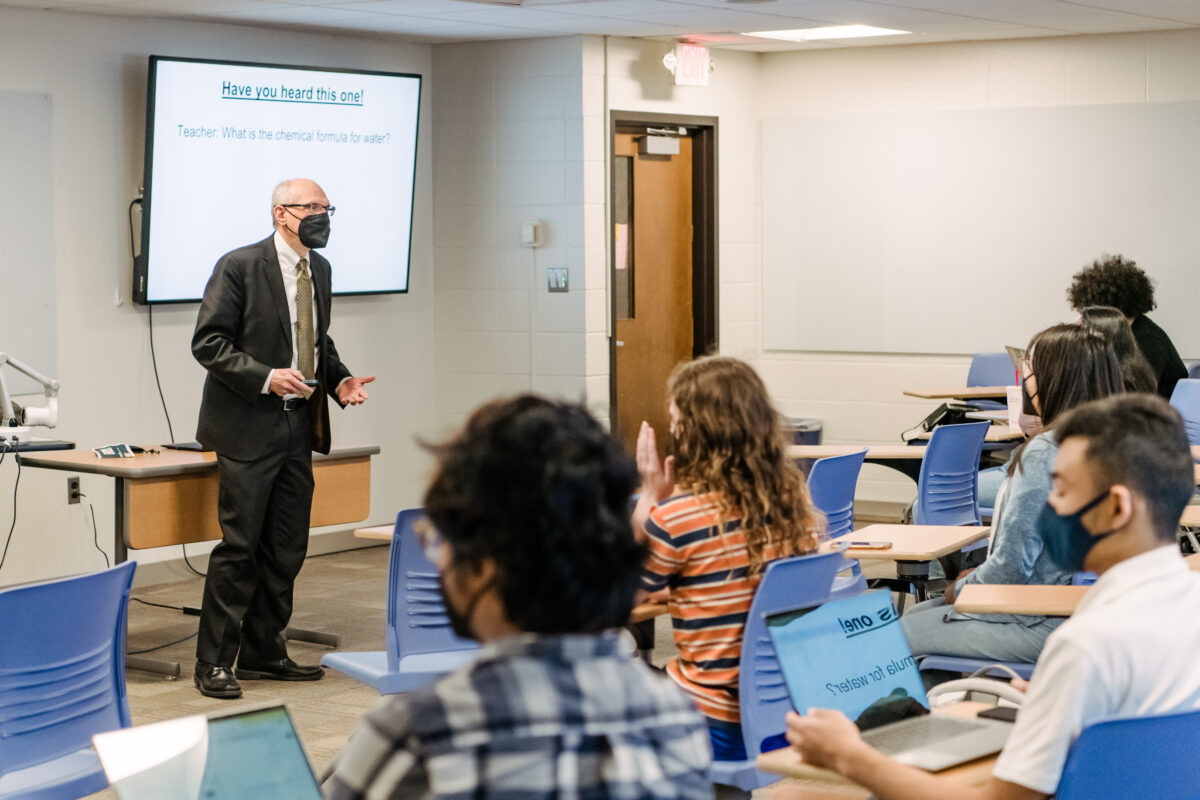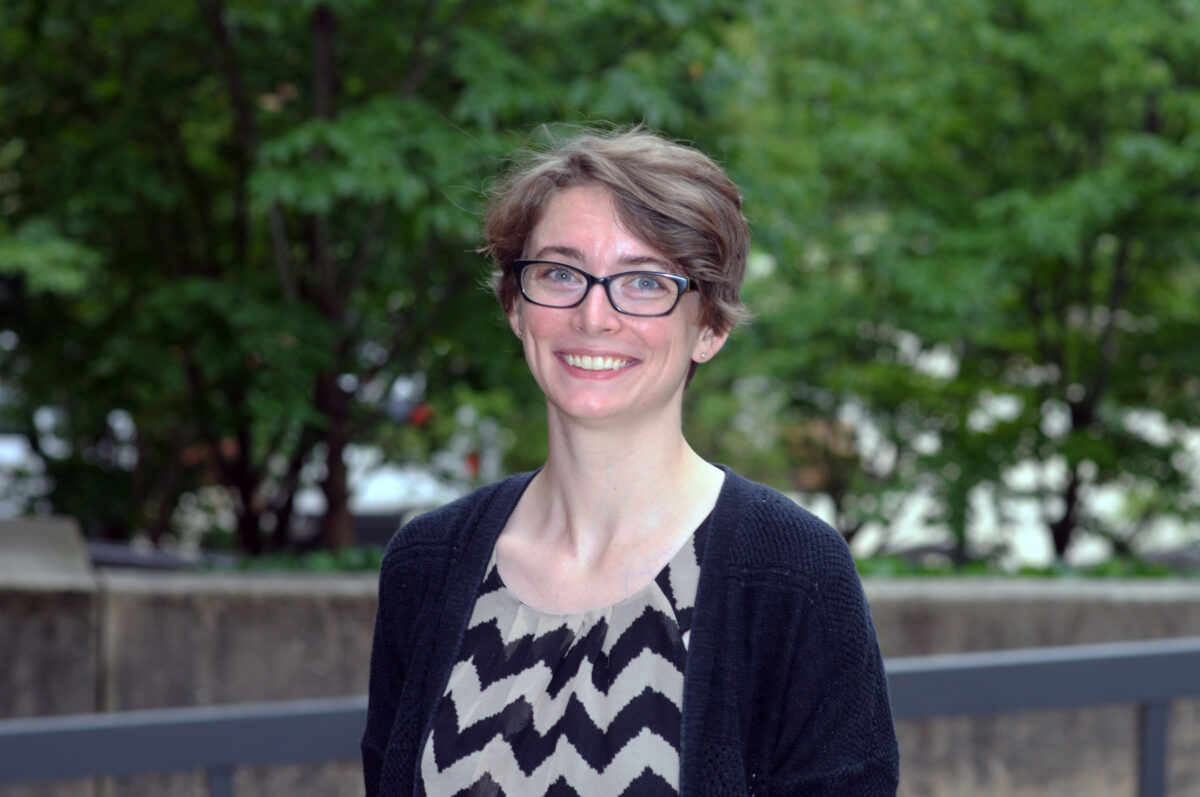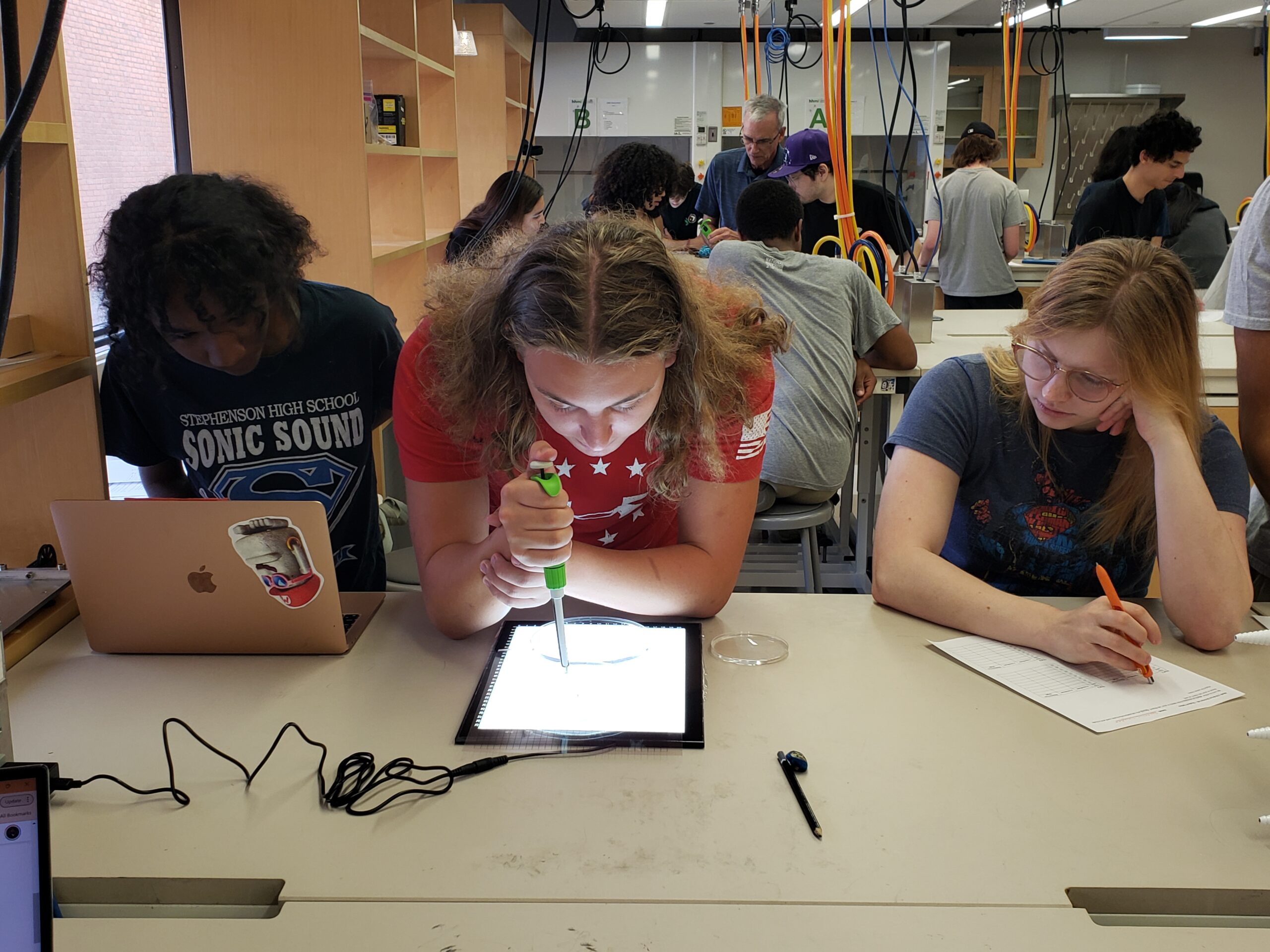UMBC’s Science Learning Collaboratory buzzes with activity as small groups of students use pipettes to suck brine shrimp out of glass vials, squirt them into petri dishes set over graph paper, then stare intently at the wriggling shrimp while running stopwatches and recording data. They’ll then analyze the data using Excel and write up a laboratory report.
It may not sound like a math class, but this is a typical day in MATH 110: Math in Action, a new laboratory course for non-STEM majors who haven’t taken calculus.
The course, which launched this fall, is a UMBC innovation designed for students “who don’t generally have the most positive association with math,” says lead lab instructor Alexis O’Malley ’18, mathematics and psychology. “But personally,” she adds, “I believe everyone can benefit from some math in their life, so this course is trying to show how different math concepts are applied across various fields.”
Lara Scott, a mathematics Ph.D. student who teaches the lecture portion of the class, concurs. “The hope is that by showing students how prevalent math is in every subject,” Scott says, “they will begin to make those connections themselves and those connections will inspire them to independently wonder how certain concepts can be explained mathematically.”
Empowering students with math
Each week, the students attend Scott’s lecture, then participate in a lab session where they apply what they learned in hands-on activities. The labs are co-designed by O’Malley and a rotating cast of faculty members from departments across the College of Natural and Mathematical Sciences (CNMS). As one might expect, faculty in mathematics and statistics contributed, and so did professors in biological sciences, chemistry and biochemistry, and physics, each exploring math concepts through their own discipline’s lens.
Lab topics include progressive tax rates and mortgage interest rates, the chemistry of mixing dyes for cake icing, card and dice games to learn probability, and more. Chuck Bieberich, professor of biological sciences, co-led the brine shrimp lab, which focused on calculating distance and velocity. William R. LaCourse, dean of CNMS and professor of chemistry and biochemistry, developed a lab where the students built and used clinometers, simple mechanical devices for estimating the height of tall objects, such as trees or buildings.
More than a year before he was teaching in MATH 110, LaCourse saw a need for a more interactive math course and began advocating for its creation. Kathleen Hoffman, professor of mathematics and associate dean in CNMS, came on board and worked with the math department to move the course forward. The resulting class is but one example of the many CNMS courses instructors have reimagined to promote active learning and engage students who otherwise might not take an interest in the natural sciences.
“Math is everywhere, and a math lab course creates opportunities for students to interact with the material in fresh, creative ways,” LaCourse says. “MATH 110 is about empowering students to make decisions and analyze situations in their daily lives—whether they’re critically evaluating statistics in the media or doubling a recipe.”

Swapping fear for fun in math class
The course is personal for O’Malley, who did not always love math herself. “I thought I was bad at it, and I hated doing things I was bad at,” she candidly recalls. “It wasn’t the math itself, it was the feeling that I had in a math class—which is how it is for a lot of people.”
A fortuitous sequence of events, including a campus job helping with professional development events for math teachers, led O’Malley from initially pursuing an English degree at UMBC to a combination of math and psychology majors as a Sherman Teacher Scholar. After that, O’Malley set out to make math courses less of a bear for her math-phobic students—and maybe even fun.
She first returned to UMBC as an adjunct professor for introductory calculus while still teaching math at Western Technical High School in Baltimore County. She now serves as a program management specialist in CNMS, and the opportunity to continue her passion—teaching math—in that role came as a delightful surprise.
Unlike calculus, where the curriculum is largely set, MATH 110 “is a growing, evolving, living course,” O’Malley says. “This lab is new and has the potential to always be new. I’m really excited about it.”
Learning to think like a mathematician

O’Malley and Scott have both witnessed substantial growth in their students this fall. Each lab report asks students to connect their work to previous labs, STEM fields, and their own lives. “That’s one of my favorite sections to read, because they always come up with examples I never would have thought of,” O’Malley says. “Sometimes they take away something that has even more depth than was my intention.”
The investigative nature of the course also supported students’ increasingly independent problem solving. Later in the semester, “Suddenly, students weren’t walking up with a blank page and asking for help, but instead explaining where they started and the specific point where they couldn’t bridge the gap on their own,” Scott shares.
As for lightbulb moments, “I wish that I had cataloged them,” O’Malley says. “But I remember their ‘aha!’ faces.”
By the end, “even in the labs where students struggled with the math, they could easily explain why and how the lab related to their life,” Scott says. “For students who won’t continue in the math field, it’s pretty incredible to watch them (sometimes begrudgingly) accept how intertwined mathematics is with our world.”
Changing minds, creating opportunities
During the last few weeks of the fall semester, rather than conducting faculty-designed labs, the students are developing their own. Next semester, the curriculum will incorporate one of the students’ labs. That process will continue, and eventually, with enough different labs to choose from, the course might become adaptable to the interests of students each semester, O’Malley says.
The spring course is filling up, which speaks to its positive reception with students. If that section fills, the college will open another. A more advanced math laboratory course is also in the early stages of development.
The new course is already opening students’ eyes to what a math class can be.
“I didn’t think you could do math and lab at the same time,” shares Taye Olorunsola ’25, management of aging services, who took a chance on the new course this fall. But now? “I recommend it to a lot of my friends.”

